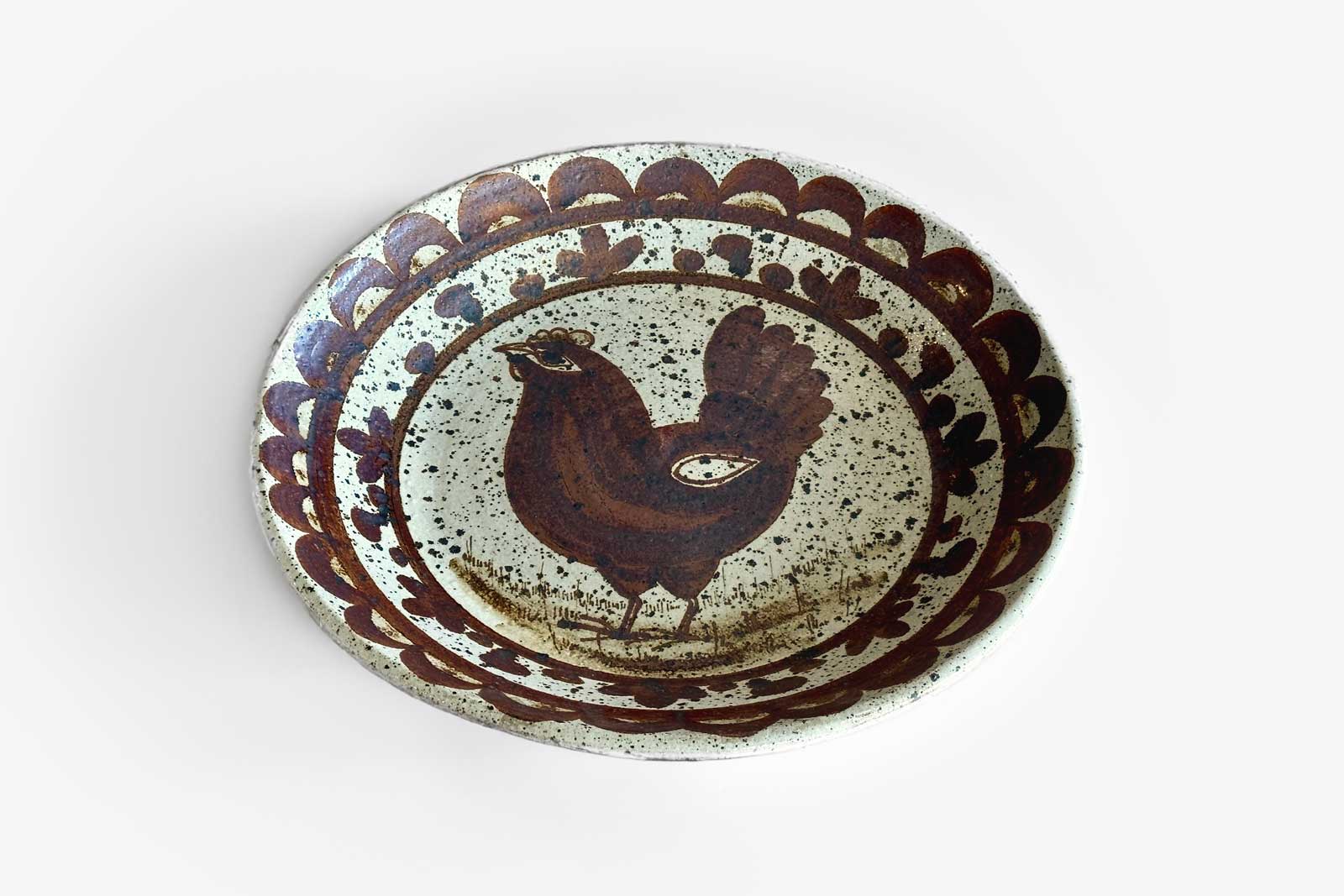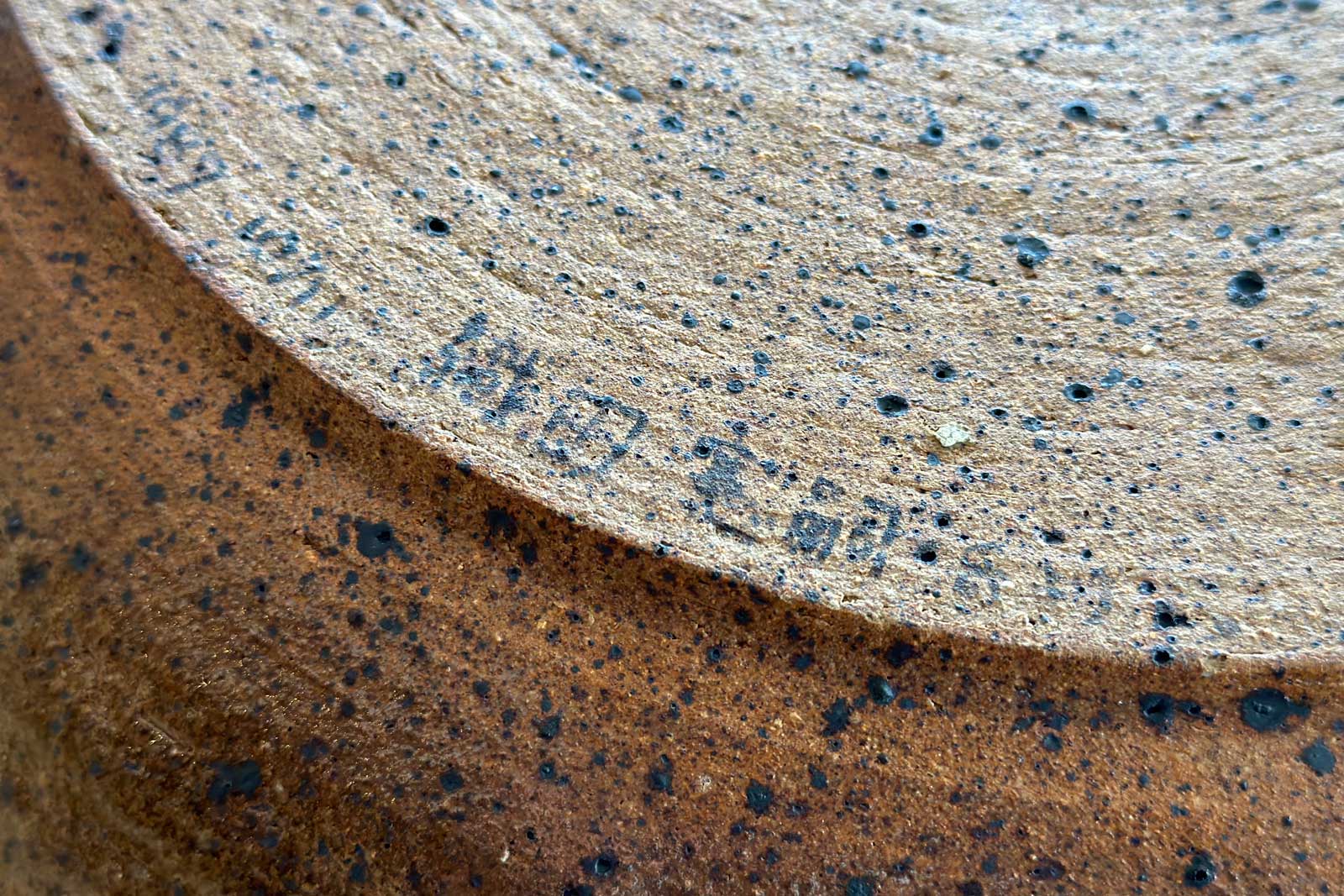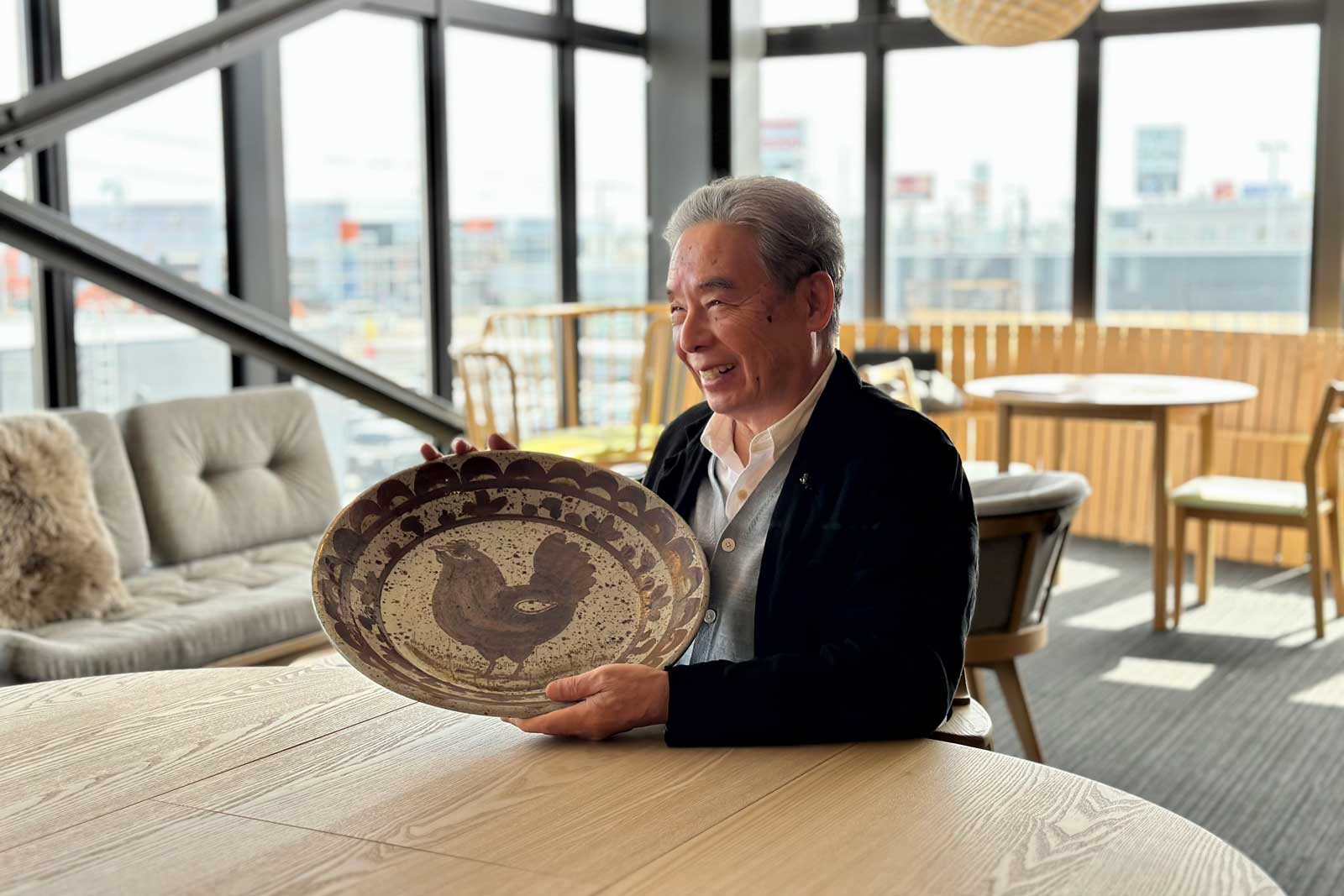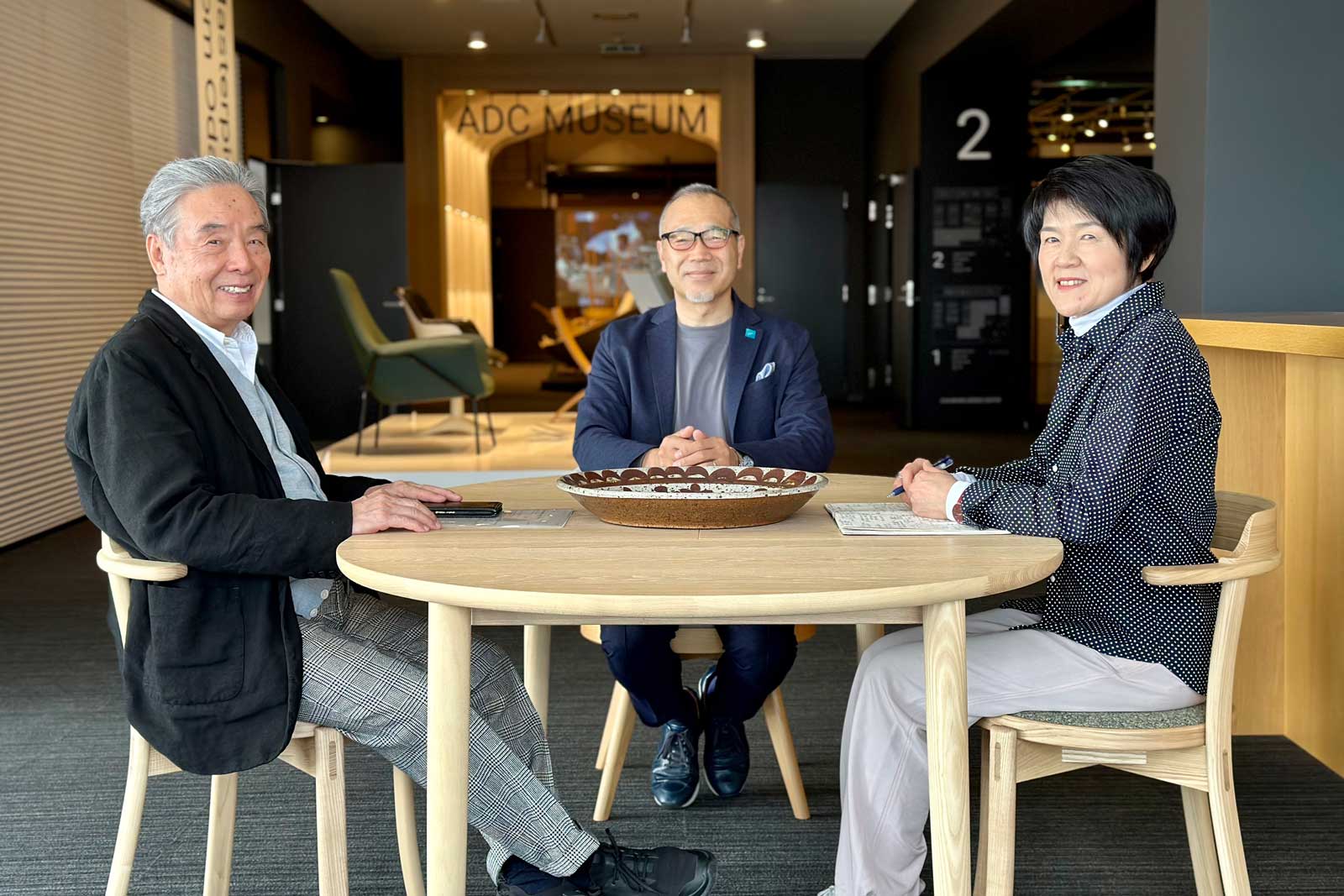
Chicken picture platter (production year unknown)
In Denmark, thick, heavy and hard pottery like this platter is called “STEN TOY”. English stoneware. In the 1980s, when Mr. Oda went to Denmark for research purposes, there were only one or two vintage shops. He had it displayed at his home in Osaka.
I liked the generous painting.
I forgot the price, but I’m sure I had a hard time buying it. (laughs).
I think I found this platter around 1984-1987. At that time, I used to go to Denmark once or twice a year. Every time I travel, I used to stay at a cheap Inn with no bath or toilet in the room (there were two toilets and showers on the first floor), while eating breakfast, made sandwiches for lunch, hid them in my bag, and left. I wanted to save as much as possible and take home as many books as possible. Meanwhile, I found this picture plate at a vintage shop. I liked the pattern and the name of the artist was written on it, so I bought it without hesitation.
I think that the reason why there were almost no vintage shops at that time was that the people did not understand the value of their country’s past designs and manufacturing, and did not look back. From 1945 to 1965, Scandinavian design flourished, especially in the 1950s and 1960s. It was after this boom had passed that I started going. In a way, I went there at the right time, so I was able to collect all this. As I repeat, the Oda collection was created by encounters with the times.
At the International Furniture Design Fair Asahikawa in 1990,
We held the Finn Juhl Memorial exhibition.
Later I gave this latter to someone. It was Mr. Manabu Tada, an architect and chairman of the executive committee for the Finn Juhl Memorial exhibition, which was held for the first time in Japan in 1990. Starting in Osaka, the exhibition traveled to Kyoto, Nagoya, Tokyo, and Asahikawa. The executive committee consists of 17 people, and the core members are Mr. Tetsuo Iku of the Sekisui House Design Department (later vice president), Ms. Eiko Senoo, a member of “Chairs”, and Denmark, who trained under Sukiya carpenter master carpenter Satoji Nakamura. People, Mr. Soren Matz, etc., joined by one person from each traveling city. Mr. Minoru Nagahara, the founder of Conde House, participated from Asahikawa. They made their own mahogany frames for posters. In Japan, where few people know the name of Finn Juhl, the exhibition was realized in five locations nationwide, so you can see how strong the passion of the core members was.
For the necessary money, donations of 10,000 yen per unit were solicited in Japan and Denmark. Mr. Mats was in charge of the English translation of the proposal.
Donations came in one after another from the Danish Embassy, the Danish Royal Family, the National Bankers Association, and others. Some people donated in units of 1 million yen, and the total amount exceeded 10 million yen. It was a time when there were patrons of culture. We also made a fine pictorial record and sold it for 1,000 yen per copy, but this pictorial record has recently been auctioned and seems to be worth 80,000 to 100,000 yen. The executive committee started at 6:00 every night and exchanged opinions on the content, display method, and division of roles, and continued until midnight each time.
Mr. Nagahara said, “This is the first time I’ve ever met an executive committee with such a high level of enthusiasm. Everyone was carried away by the virus of Finn Juhl’s charm (laugh)

I would like to thank the committee chairman
for his great cooperation in the memorial exhibition.
The exhibition ended successfully. With the remaining money, we held a consolation party at “Wakuden” in Kyoto, traveled to Yufuin in Oita with Hannah Wilhelm Hansen, Mrs. Finn Juhl, and the executive committee was dissolved. At that time, I was wondering if there was a way to express my gratitude to Mr. Manabu Tada, who, while serving as the chairman of the committee, spared no effort as an architect in setting up each venue. Mr. Tada had a strong feeling for Finn Juhl, and even though he said, “I can’t do my main job,” he took on the most troublesome work. And I decided to present my favorite platter as a present. Put my signature on the back of the plate, next to the artist’s signature.
This memorial exhibition was an epoch-making exhibition that introduced the works of Finn Juhl for the first time in Japan. Until then, it only appeared in a magazine called Kogei News around 1960. I am proud that this exhibition triggered his name and works spread in Japan. At the same time, I think that the Japanese gradually came to understand that a researcher is different from a collector who only collects things.
Approximately 30 years later,
I met this platter again in Kyoto.
In 2019, I was asked by a person who was renovating Nintendo’s Kyoto headquarters building to open a hotel, “I want you to introduce the manufacturer of Asahikawa furniture,” and I showed him around Asahikawa. Three years later, he contacted me and said that he would like to invite me because the hotel was completed. I went out with my wife. When I arrived at the hotel, I was very surprised when I was shown to a room called a luxury suite for 350,000 yen per night (laughs). The room was furnished with Conde House furniture.
The next day, I went to the vintage shop “B Generated”, which I had stopped by when I came to Kyoto for nearly 30 years. When I was looking at it, thinking that there were still good things, my wife said, “There’s an interesting plate over here.” Quietly placed in the corner of the store, it’s a nice touch. Mr. Iwai, the owner, is a familiar face and said with a grin, “That plate has Mr. Oda’s signature on the back.” Then my wife and I finally remembered, “That plate that was displayed in the living room!” I immediately said “buy”. Mr. Iwai didn’t say anything about how the things I gave Mr. Tada came to be, and I didn’t ask him either. More than anything else, I was moved by the fact that things that had once left my hands returned to me again over time. It’s strictly forbidden to buy things in front of my wife (laughs), but this time I broke it. However, it is a secret that this plate was sent along with other secret purchases.

I have been living with the awareness of
why I was born.
Recently, my wife has finally started saying, “I’m glad you worked so hard to come here.” People often ask me how I managed to pay for the purchase, but even I don’t know (laughs). I just kept working hard, working, working, working. Even if other people see it as a pastime, if you do it steadily, one day you will cross the line and become a culture. A little while ago, a friend of mine who was my partner when I opened my own office, Gabunsha, came to visit me. At that time, I was very happy when I was told, “Mr. Oda, you haven’t changed at all. It is natural that there is no blur. Now that I’ve entered the path of research.
“Ever since I was young, I was aware of what I was born for.” I don’t have the talent to continue on the path of creating things, such as illustrations and designs. Trying to set the goal of life on the side of leaving rather than on the side of creating. In fact, after I moved to Asahikawa, Mr. Nagahara from Conde House asked me to design a chair. I refused, saying that I didn’t want to throw away all that I had built up. Leaving masterpieces and making things by yourself are on a different dimension.
I cherish the words of an ancient Amazon Indio, “Those who try to leave things behind are those who lack confidence in their way of life.” I have no confidence in my way of life. However, there are beautiful things that should be preserved for future generations. I’m just doing it because someone has to do it. God is watching and lending me a hand from time to time. The platter that I was led to meet again this time is now placed on the table in front of the sofa in the living room and I am lovingly looking at it. No, I didn’t place anything on it. If I place something on it, I can’t see the beautiful picture. (laughs).
April 12th, 2023 Asahikawa Design Center 2F Lounge
Interviewer: Kano Nishikawa
[ After the interview ]
The interview was held at the newly renovated “Asahikawa Design Center” before the meeting of the Oda Collection Cooperation Committee. In the center is Mr. Tetsuya Fujita, chairman. This is a commemorative photo that I jumped into thinking, “It’s not easy to take a picture with Oda-sensei.” Mr. Oda brought the picture plate with hard work. I put it directly on the table, but as you can see in the photo in the article, there is a pad attached to the back of the plate so it’s okay. That’s Mr. Oda. Even so, this plate must have been waiting for Mr. Oda from Hokkaido to pick it up for a long long time. The plate looked as happy as Mr. Oda.

Copywriter Kano Nishikawa
After working at a design office in Tokyo and Sapporo, I started working as a freelancer in Asahikawa in 2001. Until now, I have been involved in the production of advertisements for local companies and organizations, including Asahikawa Furniture. I have known Mr. Oda for about 30 years through my work.

